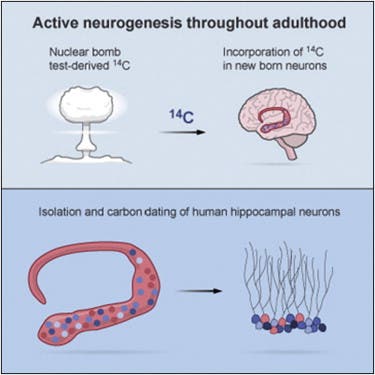A long-time assumption in the medical world is that mature, differentiated neurons do not divide and that they’re formed during the embryonic development stage. This does not necessarily mean, however, that all neurons are grown during this stage only and that they do not form during adulthood as well. Proving that neurons can form during adulthood is a difficult task however since there isn’t a way to date new neurons and thus tell them apart from those formed when we were born. A new study published in the journal Cell describes a new method that dates the birth of neurons by measuring elevated atmospheric levels of carbon-14, a nonradioactive form of carbon, caused by above-ground nuclear bomb testing more than 50 years ago.
“It was thought for a long time that we are born with a certain number of neurons, and that it is not possible to get new neurons after birth,” says senior study author Jonas Frisén of the Karolinska Institute.

To test their method, the researchers carbon-dated neurons from the brains of deceased individuals. Their findings show that some 1,400 new neurons in the dentate gyrus area are added each day corresponding to an annual turnover of 1.75% of the neurons within the renewing fraction, with a modest decline during aging.
Previously adult-born hippocampal neurons had been shown to be important for cognitive plasticity in rodents – it was unclear if the same is valid for humans as well. Since one-third of hippocampal neurons are subject to exchange, it’s reasonable to claim that adult hippocampal neurogenesis may contribute significantly to human brain function. It’s well noting too that the rate of new neuron generation declines moderately with age.
How do new neurons form, though? Here’s an excerpt from the book Neuroscience. 2nd edition, by Purves D, Augustine GJ, Fitzpatrick.
“If neurons cannot divide (see Chapter 22), how does the adult brain generate these nerve cells? The answer emerged with the discovery that the sub-ventricular zone that produces neurons during development retains some neural stem cells in the adult. The term “stem cells” refers to a population of cells that are self-renewing—each cell can divide symmetrically to give rise to more cells like itself, but also can divide asymmetrically, giving rise to a new stem cell plus one or more differentiated cells. Over the past decade, several research groups have isolated stem cells from the adult brain that can reproduce in large numbers in cell culture. Such cells can then be induced to differentiate into neurons and glial cells, when exposed to appropriate signals. Many of these same signals mediate neuronal differentiation in normal development. Adult stem cells can be isolated not only from the anterior subventricular zone (near the olfactory bulb) and dentate gyrus, but from many other parts of the forebrain, cerebellum, midbrain, and spinal cord, although they do not apparently produce any new neurons in these sites. Inhibitory signals in these regions may prevent stem cells from generating neurons.”
via KurzweilAI


